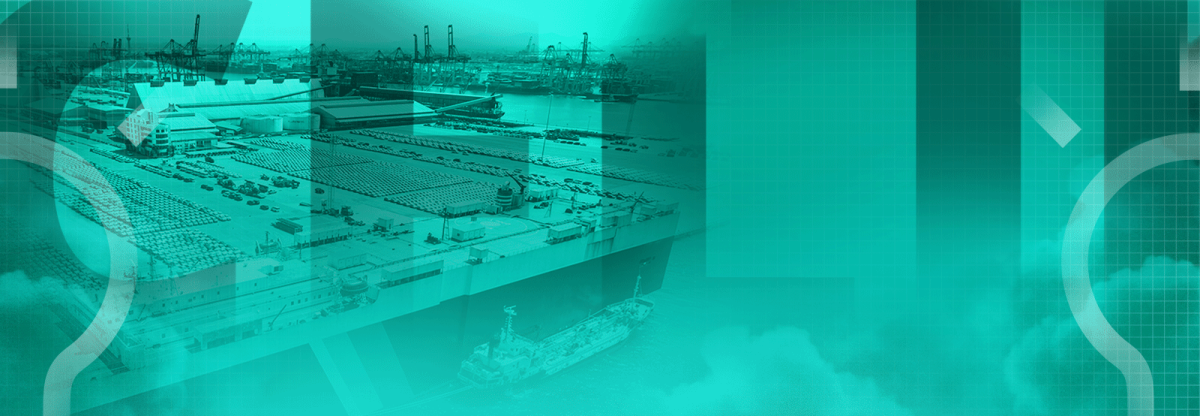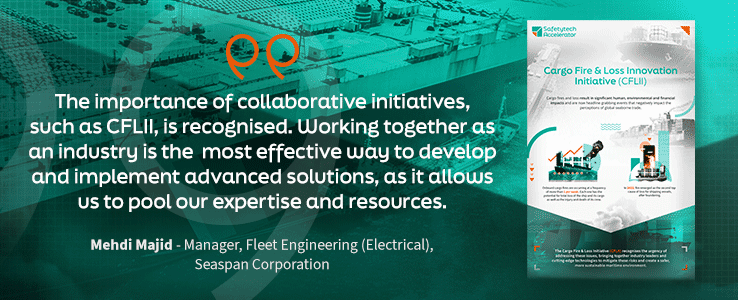Advancing Maritime Safety and Sustainability with Cutting-Edge Fire Detection
24/11/2023Innovations in Maritime Safety: Tackling Cargo Fires, Fostering Sustainability, and Unifying Industry Forces
Global container trade accounts for approximately 60% of goods shipped by sea (52% by value – Source: World Shipping Council), serving as the cornerstone of supply chains that deliver the countless products we rely on daily. Maintaining the reliability of maritime supply chains is paramount, and while major disruptions are infrequent, their repercussions are severe. Amidst the ongoing reverberations of a global pandemic and escalating regional conflicts, it becomes imperative for the global maritime supply chain to build resilience swiftly and effectively, addressing key risks and challenges head-on.
Disruption to container trade stems from various factors, ranging from the closure of key waterways to port disturbances. However, one of the most critical challenges arises from delays to vessel schedules caused by cargo fires. These fires, often associated with high-risk cargoes, can occur at any point in the supply chain. The repercussions extend beyond safety concerns and industry operations, influencing investor relations, client partnerships, and insurance premiums. Most significantly, the human toll, marked by loss of life and injury among the crew, underscores the gravity of the issue. Beyond immediate safety and operational impacts, addressing these challenges aligns with the industry’s escalating focus on sustainability and ESG considerations. Cargo fires not only jeopardise lives and goods but also pose a threat to our oceans and the delicate balance of marine ecosystems.
Industry Convergence: CFLII’s Efforts to Bring Stakeholders Together
Safetytech Accelerator launched the Cargo Fires & Loss Innovation Initiative (CFLII) to foster industry collaboration and address shared challenges using cutting-edge technologies. With a deliberate and ambitious objective, the program aims to eradicate oceanic contamination resulting from maritime incidents by proactively preventing cargo fires, loss, and damage at sea. CFLII aims to unite and coordinate industry efforts, enabling collaborative trials of technology solutions for mutual benefit. Organisations joining the initiative as ‘Anchor Partners’ play pivotal roles, ranging from defining specific challenges to evaluating technology solutions, conducting feasibility studies, and overseeing pilots – all geared towards mitigating the impact of maritime fire and loss.
Diving Deeper: CFLII’s Exploration of Maritime Fire Detection Challenges
Working with industry the CFLII programme precisely identifies and addresses distinct ‘challenges’, recognising the importance of tackling these issues not just for safety but also for the broader context of environmental sustainability. These challenges are chosen by the Initiative Anchor Partners and in 2023, the programme has centred around two connected challenges with a focus on container ship operation:
- Early-stage fire detection in the cargo hold. Fires can initiate within containers due to various factors, including the shipment of poorly manufactured or damaged goods, dangerous cargoes, and issues with packaging, securing, and segregating cargo. Containers, tightly packed within cargo holds, pose a challenge when a fire spreads from one container to another. Detecting a cargo hold ‘pre-fire or fire event ‘early is crucial, and the availability of detailed contextual information enhances the potential for successful containment and suppression onboard. Currently, standard cargo holds fire detection methods on container ships rely on sample air extraction systems that detect smoke. However, these systems are slow to identify fires and lack the necessary contextual information for an effective and proactive response, including details about the fire’s location and propagation characteristic.
- Early-stage fire detection on deck. Currently, there are no regulatory requirements for on-deck fire detection for cargo vessels, including container ships. The only means to identify fires is through sensory indications by the ship’s crew. These are visual or olfactory (smell) indications observed whilst undertaking watchkeeping duties or on-deck activities. These fires can occur at any time of day, in any weather conditions and in any sea-state.
Tech Quest: Searching for Effective Fire Detection Solutions
The problem of early fire detection is complex and multifaceted, and while the issue of detection on board container ships has been identified by CFLII Anchor Partners as most pressing, the root causes of fires often originate earlier in the supply chain. The operational environment presents exceptional challenges—isolated at sea, identifying specific elements indicative of early combustion (or pre-combustion) within a ship housing thousands of containers is demanding from both an operational and technological perspective.
There are numerous approaches to fire detection in the market, with thousands of small and large organisations contributing to this technology landscape. When considering suitability for onboard deployment each of these approaches comes with its own set of benefits and limitations. Indeed, the most suitable solution may consist of a combination of technologies. The spectrum ranges in terms of cost, complexity, and maturity. Selecting the right portfolio of technologies, therefore, becomes an intricate task, one that not only enhances safety measures but also aligns with the industry’s commitment to environmental responsibility. Striking a balance between scalability, cost-effectiveness, and performance is a formidable challenge, but a necessary and essential one as industry strides towards a maritime future that is not only secure but also environmentally sustainable.
Navigating Challenges: CFLII’s Strategic Approach to Fire Detection Solutions
Safetytech Accelerator worked with the Anchor partners to build a detailed specification of the operational context that best represented the diverse nature of container ships, through on-site inspections, interviews and the creation of photographic and videographic libraries. This information was translated into a market ready challenge brief that included all aspects of functional and non-functional requirements; from temperature sensitivity to final cost per ship – this brief was used to engage the technology market.
Initial analysis demonstrated a vast market of technologies and providers with the potential to solve the challenge of early fire detection. Safetytech Accelerator has extensive experience in evaluating technology companies for their fit for a given scenario, and the team assessed a range of factors, that tested the companies’ ability to deliver performance at scale in maritime. Certain technologies could be ruled out quickly such as some types of linear heat detection that either degrade or do not offer the necessary level of sensitivity, or some technologies like optical beams would need constant calibration so would be a poor fit for the environment.
8 different technology categories were ruled to have potential to solve the problem, these were divided these into ‘core technologies’ – approaches that are relatively established and capable of scale/performance immediately and ‘disruptors’ – technologies introduce completely novel ways of solving the challenge but are at an earlier stage of product development. This way the programme received a wide variety of approaches and risk profiles of potential solutions. The technologies were showcased for selection by the Anchor Partners.
Click on the accompanying infographic below for an insightful visual representation of the CFLII program and its technological solutions.
The Road Ahead: CFLII’s Future Plans
The programme now includes a cohort of technology companies working with initiative Anchor Partners to conduct laboratory proof of concepts, feasibility studies and preparations for ship-based pilots. As we navigate into 2024 and beyond, the CFLII is not only committed to delving deeper into existing cargo fire & loss challenges but also expanding its reach to new focus areas. This includes looking beyond the vessel itself and extending horizons into the wider supply chain. The initiative actively invites new Anchor Partners, encompassing insurance, port & terminal operations, logistics companies, and cargo owners, who share a collective commitment not only to safety but also to sustainability. This strategic expansion reflects our dedication to shaping a maritime future where innovations not only secure operations but also contribute to reducing environmental impact and a more sustainable global supply chain.
If you would like to explore this topic further or understand how you could get involved, please visit Cargo Fire and Loss Innovation Initiative (CFLII) – Safetytech Accelerator or contact our Programme Director Rich McLoughlin at richard.mcloughlin@lr.org .
About Safetytech Accelerator
Safetytech Accelerator, established by Lloyd’s Register, is the first fully dedicated technology accelerator focused on advancing innovation in safety critical industries, with a mission to make the world safer, more resilient, and more sustainable through the wider adoption of technology.
CFLII Full list of members: COSCO Shipping Lines, Evergreen Line, HMM, Lloyd’s Register, Maersk, Offen Group, ONE, Seaspan, UK P&I Club, and TT Club.


